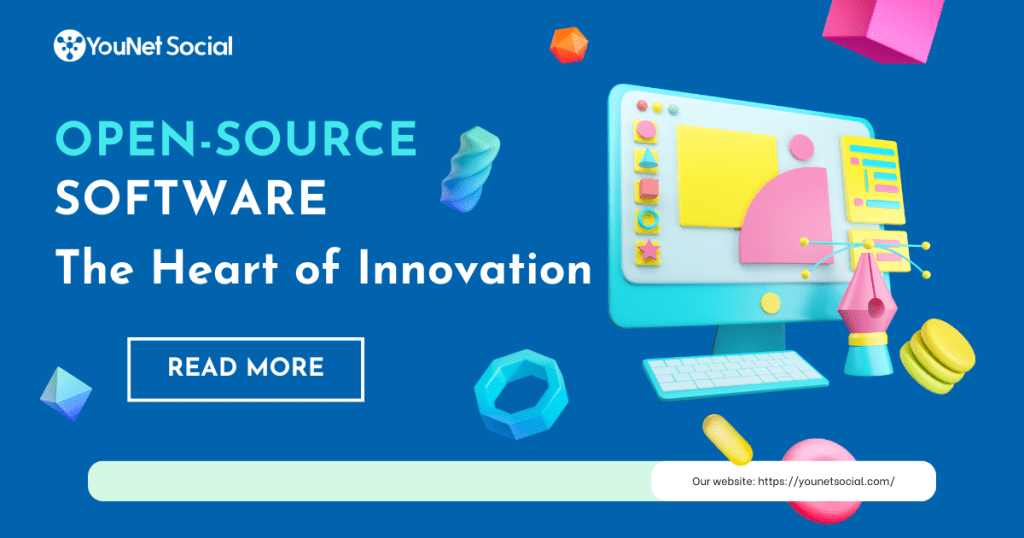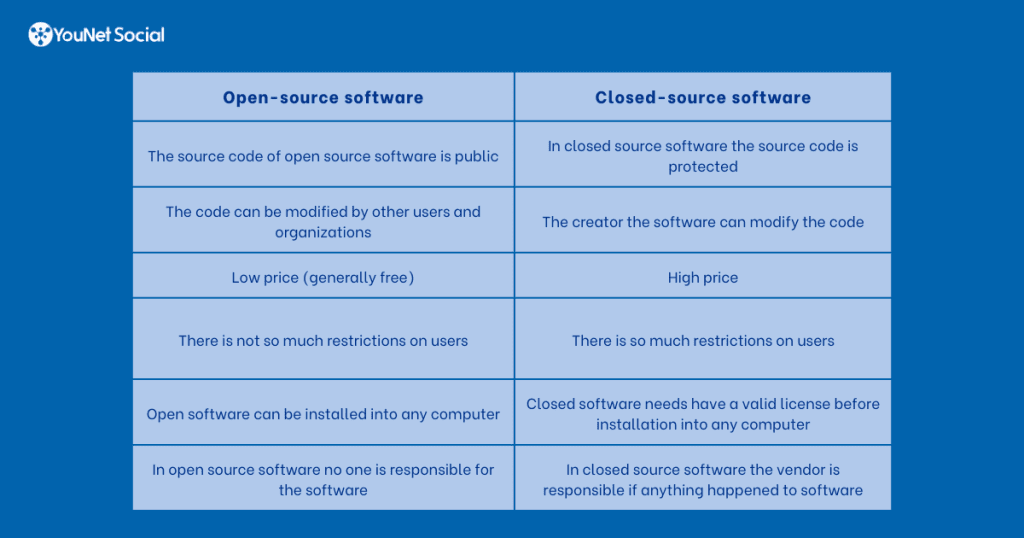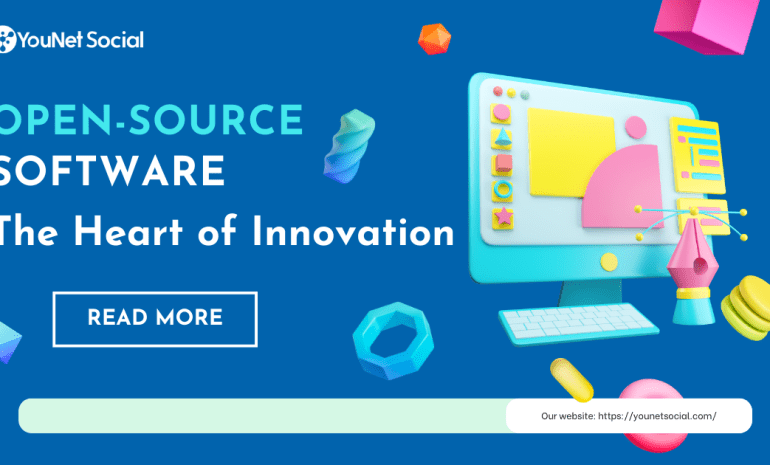It is exciting to see how every aspect of our lives is transitioning to the digital world. This shift towards innovation gives hope for a brighter future with the growth in technology. For these reasons, the appearance of open-source software has become a pivotal cornerstone in the ever-evolving landscape of technology.

Open source software, often referred to as OSS, represents not only a driving force but also the heart of tech innovation. In an era where collaboration and accessibility are paramount, open-source software stands as a shining example of the power of community-driven development and its profound impact on how we conceive, create, and consume technology.
What is open-source software?
The term ‘open’ refers to something people can easily access, use, and modify.
So, open-source software (OSS) is simply software that anyone can use to alter and change its source code for their purpose.
The differences between open-source software and other types of software
Open-source software vs. Free software
With open-source software, people can use, modify, and share with someone else. While free software enables them access without any cost of materials, it doesn’t mean they can reuse, modify, or share it with others.

Open-source software vs. Closed-source software (Proprietary software)
Closed-source software belongs to individuals or companies who generate it, and the public does not have access to the source code; thus, they cannot inspect or edit it in any manner. Closed-source software is expensive, and users must have valid and authenticated licenses. In comparison, the price of open-source software is meager.

Utilize open-source software in reality
Open-source software (OSS) in reality is widespread and has had a profound impact on various aspects of the technology industry, businesses, and society as a whole. Here are some fields in which this software plays a critical role:
Operating Systems: Linux is one of the most prominent examples of open-source software used in operating systems. It powers many servers, cloud infrastructure, and embedded devices. Based on the Linux kernel, Android is the dominant mobile operating system.
Web Servers and Services: Apache HTTP Server and Nginx are popular open-source web servers that serve a significant portion of websites on the internet. Many web-based services, including social media platforms and content management systems, rely on open-source software.
Development Tools: Open-source development tools such as Git (for version control), Visual Studio Code (an integrated development environment), and various programming languages (Python, Ruby, PHP, etc.) are widely used by developers to create software and applications.
Databases: Open-source database management systems like MySQL, PostgreSQL, and MongoDB are used extensively in web and enterprise applications. They offer robust and scalable solutions for data storage and retrieval.
Content Management Systems (CMS): Platforms like WordPress, Joomla, and Drupal are open-source CMSs that power millions of websites and blogs, making it easy for users to create and manage content.
Cloud Computing: OpenStack is an open-source platform allowing organizations to build and manage private and public clouds, offering infrastructure (IaaS).
IoT (Internet of Things): Many IoT devices and platforms use open-source software to connect and manage devices, process data, and enable communication between devices.
Education: Open-source software is often used in educational institutions as it is cost-effective and provides students with valuable skills. Linux and open-source software development tools are frequently taught in computer science programs.
Moreover, open-source software still affects many other industries. Overall, its utilization in reality continues to grow, driven by its cost-effectiveness, flexibility, and the collaborative nature of the open-source community.
Advantages of open-source software
Cost: Open-source software is generally free, and the public can use it without licensing fees.
Customization: Developers can freely customize the code to meet specific requirements.
Community support: People have a diverse set of related information, from documentation and bug fixes to improvements in the software from the community of users.
Security: The community can quickly detect and fix vulnerabilities with open-source software.
Transparency: Since the source code is open, users can see how the software works and what data it collects.
Disadvantages of open-source software
Limited technical support: While a large community of developers can help troubleshoot issues, professional technical support is not guaranteed.
Complexity: Open-source software can be more challenging to set up and configure than closed-source software, especially for users unfamiliar with software development.
Lack of features: Open-source software may not have all the features available in closed-source software, especially for niche or specialized industries.
Examples of open-source software platforms
Linux: Linux is one of the most well-known open-source operating systems. Its impact is felt in numerous domains, from data centers and cloud computing to mobile devices and embedded systems, such as Ubuntu, CentOS, and Debian.
Mozilla Firefox: Firefox is an open-source web browser developed by Mozilla. It’s known for its focus on privacy and user customization through extensions. It provides a secure and user-centric browsing environment and fosters a community of developers and users dedicated to an open and user-friendly web.
GIMP: GIMP is a powerful, open-source raster graphics editor often compared to Adobe Photoshop. It is part of the GNU Project and is available for multiple platforms, including Windows, macOS, and Linux. GIMP’s primary purpose is to enable users to manipulate and edit digital images with a wide range of features and capabilities.
WordPress: WordPress is a prevalent open-source content management system (CMS) primarily used for creating websites and blogs. It has evolved from a simple blogging platform into a versatile and robust CMS that powers a significant portion of the web.
MySQL: MySQL is an open-source relational database management system (RDBMS) known for its speed, reliability, and scalability. It is crucial in managing and organizing data in various applications and systems.
Python: Python is a versatile and widely used open-source programming language known for its simplicity, readability, and extensive libraries and frameworks. It has gained immense popularity in various domains, including web development, data science, machine learning, scientific computing, and more.
Git: Git is a widely used, open-source distributed version control system (VCS) that is pivotal in tracking changes and managing collaborative software development projects. It’s essential for collaborative software development, allowing multiple developers to work on the same project.
PHP: PHP is a widely-used, open-source scripting language particularly well-suited for web development. It is embedded within HTML code to create dynamic web pages, making it an essential component of many web applications and websites. PHP’s versatility and simplicity have contributed to its popularity among developers.
Our team – YouNet Social, a web and mobile application development company, has joined the community of open-source software users with whom we provide services and products, collaborating with this software to develop the platforms. We utilize open-source software such as MySQL, WordPress, PHP, PostgreSQL, and more for our stages of software development. If you want to cooperate to develop applications for businesses or individuals, don’t hesitate to contact us for quick advice and support. We have trusted and experienced experts to help you build your dream.


Leave a Reply